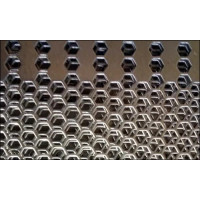_____________________________________________________________________________________________________________________________________________________________________________________________液压过滤器用穿孔管
材料:镀锌碳钢
外径x内径x厚度
20. 7x15. 7x2. 5毫米
31. 1x26. 1x2. 5毫米
33. 8x28. 8x2. 5毫米
35. 030. 0x2. 5毫米
58. 056. 0x3. 0毫米
66. 7x60. 7x3. 0毫米
弯曲穿孔钢管
21mm管
壁厚:2mm
穿孔有4mm和6mm的孔。
管道长度340mm
材料:钢
暴露在高温和油中使用
外径100mm的穿孔钢管
外径100mm的穿孔钢管
用作1-3/4左右的屏蔽在1000F下运行的排气管。
穿孔管连接到一块4ID柔性排气软管。
穿孔允许空气吸入柔性软管以冷却内管。这种类型的穿孔是刚性的,允许空气流动。
长度从9-12不等长度。

用于制造汽车高性能排气系统的穿孔管。
外径30 x厚度1 mm x长度6米
穿孔类型:孔尺寸3mm,三角缝4mm
碳钢穿孔管

穿透的碳钢管通常被热水浸泡,以强化其抗腐蚀性能。
无锈钢管抗腐蚀、抗生锈、回收、汽车废气应用理想。
穿孔钢管是用圆形、方形、空洞、直式或交错设计制造的。
穿穿钢钢管材料
穿透管是一种焊接钢管,由轻钢或409、439、304、316不锈钢穿透材料制成。
根据特性选择适当的钢材料:
不锈钢是最耐腐蚀材料,其合金因工作环境不同而具体不同。
碳钢是最腐蚀性最强的,因此也是最廉价的三种穿孔金属中最常见的。以下所列的碳钢类型都称为热滚或冷滚(例如冷滚商业钢),通过滚动平整成所期望的厚厚度,在钢仍然热时或冷冷冷后再次使用一次,以下每一类碳钢被称作热滚或冷滚(例如冷滚商业钢),工艺的不同导致产品在成本、质量和机械特性方面出现差异。简言之,热滚动通常价格较低,以厚度表7-16制成,而冷滚动则提供更紧的容度、更好的表面完成量,虽然实际上可以用任何量表生产,但最容易在薄度表14-28中找到。
由于碳钢容易腐蚀,通常用于未暴露的应用或涂层保护,涂料和粉末等涂料在穿孔后施用,完全保护材料。 锌基涂层金属(如加热、加热等)则由磨坊生产和供应,可能无法完全保护其碳核心在穿孔过程中暴露的材料。
常见穿透性碳钢类型
商业钢(HR、CR、GALV)是一种低成本的钢,具有良好的绘画、形成和焊接质量、中度体力、但因老化而受压力、抽筋和断裂影响的钢。 为了减少老化的影响,建议使用“绘图钢 ” 。
钢(HR、CR)
与商业钢公司相比,在制造期间能提高性能的钢材的通风和性能统一程度更高,这种钢材在制造期间的担架菌株或抽筋令人反感和/或性能的一致性很重要时建议使用。
形成钢(GALV)
钢的强度和长度都低于商业钢。 当压力从裂缝形成或削弱商业钢时,建议使用这种压力。














